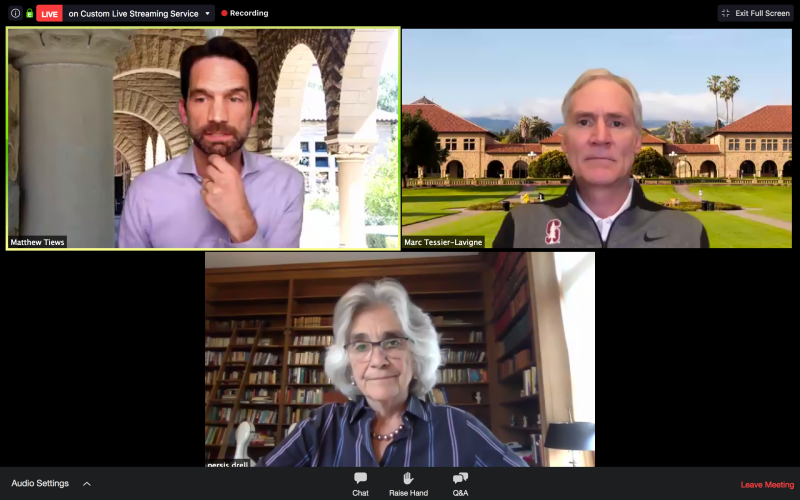As the University works to mitigate the widespread financial losses resulting from the COVID-19 pandemic, administrators remain determined to resume on-campus education by fall quarter, said President Marc Tessier-Lavigne and Provost Persis Drell during a community-wide Zoom call on Monday.
Tessier-Lavigne said that administrators are balancing three major priorities while navigating the University through a deeply uncertain period: supporting the Stanford community, positioning the school for an optimal recovery and contributing to the greater fight against COVID-19.
Those priorities come as the University faces even wider financial losses from the pandemic than from the damage of the 2008-09 economic crisis, according to Drell. In addition to damaging returns from the endowment pool, the health crisis has eliminated several major sources of income for the year, such as residential housing and summer programs.
The University is actively deploying emergency reserves to “respond to the immediate needs in front of us,” Drell said, adding that future spending cuts will be required to weather the crisis.
In response to the question of impending layoffs, Drell said the University is “striving to maintain employment continuity to the greatest extent possible,” adding that the administration greatly appreciates campus staff.
However, Stanford has not committed to supporting on-campus workers who are employed through external contracting companies such as UG2, a move which has drawn criticism from student activists and influential alumni alike, including former U.S. Secretary of Housing and Urban Development and presidential candidate Julian Castro ’96.
“Because we have placed a priority on minimizing the impacts to our regular Stanford workforce, we are not in a position to extend commitments to all the employees of all of our contractors,” Drell said.
Although the pandemic has already interfered with University fundraising efforts, Tessier-Lavigne noted an influx of alumni and other supporters reaching out to provide financial support for Stanford’s ongoing efforts to combat COVID-19.
Additionally, Tessier-Lavigne said Stanford had submitted an application for funding from the Federal Emergency Management Agency in order to support medical research and treatment happening within the University in the face of financial losses.
“We do anticipate receiving some federal stabilization funds, but they’re really, I regret to say, at levels that are relatively small compared to the overall impact of the pandemic on our budget,” he said.
Vice Provost for Student Affairs Susie Brubaker-Cole briefly appeared on the call in response to questions about students’ belongings, many of which were left behind in anticipation of a partially on-campus spring quarter.
“Our hope for the future is to be able to schedule time when students who are able to may return to campus, and pack their things and take them home,” she said. “Unfortunately, we don’t have a sense yet when the outbreak of the virus will have receded to the point where we could feel it safe, both for individuals and for communities, to return to campus to pack and retrieve things.”
Professional movers have begun packing up some students’ rooms in order to make space for healthcare workers, first responders and people awaiting COVID-19 test results.
Regarding other disruptions to student life, Tessier-Lavigne reaffirmed that 2020 graduates will, eventually, be honored in an on-campus commencement, the timing of which will be dependent on the course of the pandemic.
As for the cancellation of on-campus programs held late in the summer, like Sophomore College, Drell felt that preemptive action was necessary in order to prioritize the University’s ability to fully reopen for the fall quarter.
“The distraction, if you will, of holding out the hope that some of these other earlier programs would also be able to be in person starts to get in the way of the focus on the fall,” she explained.
Drell said that her own experience guiding Stanford through weeks of unprecedented ambiguity and turbulence bore out the University’s decisions in response to COVID-19.
“Every time we made a decision, and it felt like the decision was overreaching — we had gone too far, we were being too cautious— it took about 20 have hours for us to come to the realization that if anything, it wasn’t far enough, this has the crisis has moved so fast and our world has changed so fast,” Drell said.
Contact Grace Carroll at gac23 ‘at’ stanford.edu.
